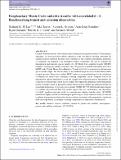Exoplanetary Monte Carlo radiative transfer with correlated-k - I. Benchmarking transit and emission observables
Abstract
Current observational data of exoplanets are providing increasing detail of their 3D atmospheric structures. As characterization efforts expand in scope, the need to develop consistent 3D radiative-transfer methods becomes more pertinent as the complex atmospheric properties of exoplanets are required to be modelled together consistently. We aim to compare the transmission and emission spectra results of a 3D Monte Carlo radiative transfer (MCRT) model to contemporary radiative-transfer suites. We perform several benchmarking tests of an MCRT code, Cloudy Monte Carlo Radiative Transfer (CMCRT), to transmission and emission spectra model output. We add flexibility to the model through the use of k-distribution tables as input opacities. We present a hybrid MCRT and ray tracing methodology for the calculation of transmission spectra with a multiple scattering component. CMCRT compares well to the transmission spectra benchmarks at the 10s of ppm level. Emission spectra benchmarks are consistent to within 10 per cent of the 1D models. We suggest that differences in the benchmark results are likely caused by geometric effects between plane-parallel and spherical models. In a practical application, we post-process a cloudy 3D HD 189733b GCM model and compare to available observational data. Our results suggest the core methodology and algorithms of CMCRT produce consistent results to contemporary radiative transfer suites. 3D MCRT methods are highly suitable for detailed post-processing of cloudy and non-cloudy 1D and 3D exoplanet atmosphere simulations in instances where atmospheric inhomogeneities, significant limb effects/geometry or multiple scattering components are important considerations.
Citation
Lee , G K H , Taylor , J , Grimm , S L , Baudino , J-L , Garland , R , Irwin , P G J & Wood , K 2019 , ' Exoplanetary Monte Carlo radiative transfer with correlated- k - I. Benchmarking transit and emission observables ' , Monthly Notices of the Royal Astronomical Society , vol. 487 , no. 2 , pp. 2082-2096 . https://doi.org/10.1093/mnras/stz1418
Publication
Monthly Notices of the Royal Astronomical Society
Status
Peer reviewed
ISSN
0035-8711Type
Journal article
Description
G.K.H. Lee acknowledges support from the University of Oxford and CSH Bern through the Bernoulli fellowship. G.K.H Lee acknowledges funding from the European community through the ERC project EXOCONDENSE (740963). The participants of the OWL 2018 summer program are thanked for numerous discussions and encouragement on the development of the model. J. Taylor is a Penrose Scholar and would like to thank the Oxford Physics Endowment for Graduates (OXPEG) for funding this research. J-L Baudino acknowledges the support of the UK Science and Technology Facilities Council.Collections
Items in the St Andrews Research Repository are protected by copyright, with all rights reserved, unless otherwise indicated.

